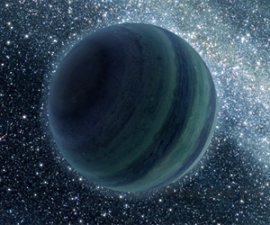Planet without orbit!

An international team of astronomers has found a young planet, which is unique in that it does not orbit, that is not moving around certain stars. This freely moving planet, dubbed PSO J318.5-22, located at a distance of only 80 light years from Earth, and its mass is about 6 times the mass of Jupiter. It is assumed that the planet is quite "young". Do scientists have every reason to think that she was not more than 12 million years. For the first time a weak thermal radiation PSO J318.5-22 been identified by scientists using the Pan-STARRS 1 (PS1) of the American auto telescope built atop the Hawaiian volcano Haleakala. Follow-up observations of other observatories erected in Hawaii showed that their properties identical planet planets gas giants orbiting young stars. However, all attempts of astronomers detected the parent star PSO J318.5-22 planet have failed. Astronomers came to the unanimous opinion that the "discovery" is a single astronomical object. According to the head group of researchers Dr. Michael Liu of the University of Hawaii at Manoa, he and his colleagues had never before had to watch the space object, like a planet PSO J318.5-22, which is surrounded by many stars, but it is a "hermit". The scientist admitted that he very often wondered whether such remote astronomical objects exist. Over the past decade, the search for and identification of exoplanets reached incredible pace. Scientists have developed more than thousands of different detection methods, such as eclipse and stars around which exoplanets are expected to, but because of their brightness slightly very difficult to see. Nevertheless, only a fraction of exoplanets manages captured in pictures - they all move around young stars, whose age is less than 200 million years.. PSO J318.5-22 is one of the small mass of moving objects, and the lowest possible. According to Niall Deacon of the Max Planck Institute for Astronomy (Germany), the planets, which are identified by the "direct" observations, it is extremely difficult to study in the future, because they are in close proximity with their brighter parent stars. Deacon notes that in the case of PSO J318.5-22 - everything is completely different, because the planet is not a companion star, which greatly facilitates research. The scientist does not rule out that the study of this particular planet will help scientists to understand the specifics of the processes occurring inside the gas giant planets, means, for example, it is Jupiter. PSO J318.5-22 was discovered during a search for "failed" stars, known as brown dwarfs. Because of their relatively low temperature, they are extremely faint, which makes brown dwarfs referred to the number of normal stars. How to plant, during these observations of astronomical objects are characterized by a red glow. Liu and his colleagues observed the night sky using the PS1 telescope for several days, armed with ultra-sensitive camera, in order to detect weak heat "traces" brown dwarfs. Their attention was drawn to the object, which was characterized by a bright red glow, rather than typical for brown dwarfs. Dr. Eugene Magnier from the Institute for Astronomy at the University of Hawaii at Manoa led the team of researchers, which is engaged in the processing of data PS1. It is difficult to imagine that treated daily about 60 thousand photos. Studies have shown that the observed red object is not a brown dwarf. By regularly monitoring the situation PSO J318.5-22 for two years with the help of Canada-France-Hawaii Telescope, a team of researchers were able to measure the distance from the planet to the Earth and to study its characteristics. Based on the fact that the planet away from Earth at a distance of about 80 light-years, and given the specificity of its motion in space, the researchers came to the conclusion that the PSO J318.5-22 relates stellar kinematics Beta Pictoris, formed about 12 million. Years ago . The fact that the PSO J318.5-22 less weight than the star-nominal group β Pictoris, indicates that probably planet formed entirely different way. How? - Scientists and is to be seen in the future.
Sours: http://kosmos-x.net.ru/
Maybe it's not a planet : )